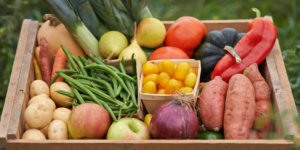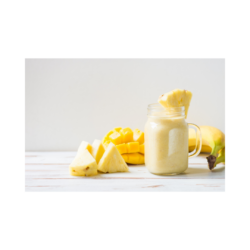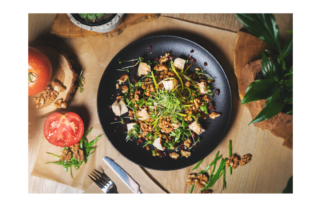A Natural, Real-Foods Approach
Focus on filling your plate with natural, real foods. Vegetables should take up the remaining 80 percent of your plate, while high quality proteins and fat make up the remaining 20 percent. Fruits are full of beneficial nutrients, but should not take up a significant percentage of your plate. You can add a piece of fruit to your balanced meal or snack.
Food Quality
Purchase organic fruit and vegetables that are free of chemicals and pesticides. While getting organic produce from your grocery store is good, local farmers’ markets are better. 
Eat with the seasons. If a fruit or vegetable doesn’t grow in the winter where you live, skip it at the grocery store until spring or summer, the time it naturally grows. Your body was meant to eat with the seasons. This helps prevent food sensitivities and ensures that you are getting a wide range of nutrients from foods that you may not normally eat.
Many conventional meats come from cows, pigs, and chickens that are fed a grain or corn rich diet. Farmers give grain and corn to animals in an attempt to fatten them up quickly and inexpensively. Since this isn’t the animal’s natural food source, it affects the quality of the meat.
The best meat carries three labels: organic, grass-fed and pasture-raised. Do your best to choose the highest quality meats while staying within your budget.
Choose eggs that are organic, free-range and pasture raised. These high quality eggs contain more omega-3 fatty acids than their conventional counterparts and are often higher in vitamins A and E. This is because pasture-raised chickens eat their normal diet – grass and bugs – instead of the conventional diet of grains and corn.
Nuts are a good source of healthy protein and fat. Try to include a healthy source of fat at every meal. Nuts are higher in omega-6 fatty acids than omega-3 fatty acids. Eating too many omega-6 fatty acids without balancing them out with omega-3 fatty acids can actually contribute to gut inflammation and gut damage. Vary your fat sources by including avocados, olives, olive oil, coconut oil, coconut flakes, full-fat canned coconut milk, grass-fed ghee, and grass-fed butter into your diet.
Eating right for your gut is not just about what you eat, but how you eat as well. Digestion is a complicated process that requires many different chemical reactions to take place at the same time. Different types of food requires different enzymes and pH levels for proper breakdown. Your digestive system is designed to handle all of these chemical reactions. Ease your digestive burden by eating protein with vegetables instead of non-gluten grains, rice or legumes. When eating grains, rice or legumes, pair them with vegetables.
Here is a gut-health Snack Recipe for you! Enjoy!

Tropical Smoothie
Ingredients
- 1 small mango (about 1 cup diced)
- 1/2 small pineapple (about 1 cup diced)
- 1 large very ripe banana, sliced
- 1 cup unsweetened pineapple juice
- 1/2 cup coconut milk
- 1 tsp fresh lime juice
Instructions
- Peel and pit mango, then dice. Peel and core pineapple, then dice.
- Arrange banana, mango, and pineapple in a single layer on a baking sheet.
- Cover and freeze until fruit is frozen solid, about 2 hours
- Combine all ingredients in a blender. Cover and blend on high speed for 1 minute, or until smooth. Serve Immediately.
For more help with gut health and overall well-being, contact us here! We would be happy to help with making a plan for optimizing digestion and gut health.
[wpforms id=”9068″]
Next up – Avoiding Chemicals and Processed Foods-find it here!





